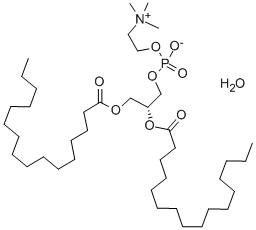1,2-DIDECANOYL-SN-GLYCERO-3-PHOSPHOCHOLINE
Synonym(s):1,2-dicapryl-sn-glycero-3-phosphocholine; PC(10:0/10:0)
- CAS NO.:3436-44-0
- Empirical Formula: C28H56NO8P
- Molecular Weight: 565.72
- MDL number: MFCD00063538
- SAFETY DATA SHEET (SDS)
- Update Date: 2023-06-08 09:01:57

What is 1,2-DIDECANOYL-SN-GLYCERO-3-PHOSPHOCHOLINE?
Description
Phosphatidylcholine species are a common class of phospholipids that comprise the mammalian cell membrane. 1,2-Didecanoyl PC (DPC) is a synthetic, less hydrophobic phospholipid that has been found to be useful for enhancing the absorption of peptide drugs and hormones such as insulin. Thus, the bioavailability of intranasally applied human growth hormone is enhanced when coadministered with the absorption enhancer DPC.
The Uses of 1,2-DIDECANOYL-SN-GLYCERO-3-PHOSPHOCHOLINE
1,2-Didecanoyl PC is a synthetic phospholipid.
What are the applications of Application
1,2-Didecanoyl PC is a synthetic phospholipid
Definition
ChEBI: A 1,2-diacyl-sn-glycero-3-phosphocholine in which the acyl groups at positions 1 and 2 are specified as capryl (decanoyl).
Properties of 1,2-DIDECANOYL-SN-GLYCERO-3-PHOSPHOCHOLINE
| storage temp. | −20°C |
| solubility | Ethanol: 30 mg/ml; DMF: 20 mg/ml; DMSO: 20 mg/ml; Ethanol:PBS (pH 7.2)(1:1): 0.5 mg/ml |
| BRN | 3757665 |
Safety information for 1,2-DIDECANOYL-SN-GLYCERO-3-PHOSPHOCHOLINE
| Signal word | Danger |
| Pictogram(s) |
 Skull and Crossbones Acute Toxicity GHS06  Health Hazard GHS08 |
| GHS Hazard Statements |
H302:Acute toxicity,oral H315:Skin corrosion/irritation H319:Serious eye damage/eye irritation H331:Acute toxicity,inhalation H336:Specific target organ toxicity,single exposure; Narcotic effects H351:Carcinogenicity H372:Specific target organ toxicity, repeated exposure |
| Precautionary Statement Codes |
P202:Do not handle until all safety precautions have been read and understood. P301+P312:IF SWALLOWED: call a POISON CENTER or doctor/physician IF you feel unwell. P302+P352:IF ON SKIN: wash with plenty of soap and water. P305+P351+P338:IF IN EYES: Rinse cautiously with water for several minutes. Remove contact lenses, if present and easy to do. Continuerinsing. P308+P313:IF exposed or concerned: Get medical advice/attention. |
Computed Descriptors for 1,2-DIDECANOYL-SN-GLYCERO-3-PHOSPHOCHOLINE
New Products
(S)-3-Aminobutanenitrile hydrochloride 4-Methylphenylacetic acid N-Boc-D-alaninol N-BOC-D/L-ALANINOL Tert-butyl bis(2-chloroethyl)carbamate 3-Morpholino-1-(4-nitrophenyl)-5,6-dihydropyridin- 2(1H)-one Furan-2,5-Dicarboxylic Acid Tropic acid 1-Bromo-3,5-Di-Tert-Butylbenzene S-2-CHLORO PROPIONIC ACID ETHYL ISOCYANOACETATE 2-Bromo-1,3-Bis(Dimethylamino)Trimethinium Hexafluorophosphate 4-IODO BENZOIC ACID 3-NITRO-2-METHYL ANILINE 1-(2,4-DICHLOROPHENYL) ETHANAMINE (2-Hydroxyphenyl)acetonitrile 4-Bromopyrazole 2-(Cyanocyclohexyl)acetic acid 4-methoxy-3,5-dinitropyridine 1-(4-(aminomethyl)benzyl)urea hydrochloride 2-aminopropyl benzoate hydrochloride diethyl 2-(2-((tertbutoxycarbonyl)amino) ethyl)malonate tert-butyl 4- (ureidomethyl)benzylcarbamate Ethyl-2-chloro((4-methoxyphenyl)hydrazono)acetateRelated products of tetrahydrofuran

![PHOSPHATIDYLCHOLINE, L-ALPHA-DIPALMITOYL, [CHOLINE-METHYL-14C]](https://img.chemicalbook.in/StructureFile/ChemBookStructure2/GIF/CB9684731.gif)


![PHOSPHATIDYLCHOLINE, L-ALPHA-DIPALMITOYL, [CHOLINE-METHYL-3H]](https://img.chemicalbook.in/CAS/GIF/66030-24-8.gif)

![PHOSPHATIDYLCHOLINE-L-ALPHA-DIPALMITOYL, [2-PALMITOYL-1-14C]](https://img.chemicalbook.in/CAS/GIF/109971-57-5.gif)
![1,2-DI[PERDEUTERO]HEXADECANOYL-SN-GLYCERO-3-PHOSPHOCHOLINE](https://img.chemicalbook.in/CAS/GIF/29287-66-9.gif)
You may like
-
 10:0 PC CAS 3436-44-0View Details
10:0 PC CAS 3436-44-0View Details
3436-44-0 -
 10:0 PC CAS 3436-44-0View Details
10:0 PC CAS 3436-44-0View Details
3436-44-0 -
 1975-50-4 98%View Details
1975-50-4 98%View Details
1975-50-4 -
 2-HYDROXY BENZYL ALCOHOL 98%View Details
2-HYDROXY BENZYL ALCOHOL 98%View Details
90-01-7 -
 2-Chloro-1,3-Bis(Dimethylamino)Trimethinium Hexafluorophosphate 221615-75-4 98%View Details
2-Chloro-1,3-Bis(Dimethylamino)Trimethinium Hexafluorophosphate 221615-75-4 98%View Details
221615-75-4 -
 61397-56-6 CIS BROMO BENZOATE 98%View Details
61397-56-6 CIS BROMO BENZOATE 98%View Details
61397-56-6 -
 14714-50-2 (2-Hydroxyphenyl)acetonitrile 98+View Details
14714-50-2 (2-Hydroxyphenyl)acetonitrile 98+View Details
14714-50-2 -
 118753-70-1 98+View Details
118753-70-1 98+View Details
118753-70-1
Statement: All products displayed on this website are only used for non medical purposes such as industrial applications or scientific research, and cannot be used for clinical diagnosis or treatment of humans or animals. They are not medicinal or edible.